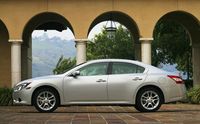2009 Nissan Maxima Review
THE AUTO PAGE
By JOHN HEILIG
SPECIFICATIONS
Model: 2009 Nissan Maxima
Engine: 3.5-liter V6
Horsepower/Torque: 290 hp @ 6400 rpm/261 lb.-ft. @ 4400 rpm
Transmission: CVT
Wheelbase: 109.3 in.
Length/Width/Height: 190.6 x 73.2 x 57.8 in.
Tires: P245/45R18 all-season
Cargo volume: 14.2 cu. ft.
Fuel economy: 19 mpg city/26 mpg highway
Fuel capacity: 20.0 gal.
Sticker: $29,000 (est.)
The Bottom Line: Nissan’s aggressive redesign of the flagship Maxima is a stylistic and performance winner. From every angle, the new Maxima is stunning and curvaceous. From behind the wheel, its road manners are exemplary. When you kick in the power, it emits a quiet growl and becomes a street racer par excellence.
When Nissan received the charter to redesign the flagship Maxima sedan, they could have taken one of two directions. They could have played it safe and gone with a simple facelift, adding a bigger engine and tweaking the sixth-generation design into a mildly changed seventh generation.
Or, they could have taken the path they took; go for broke with the physical design and make the changes necessary to reclaim the title “four-door sports car” (or 4DSC in Nissan-speak).
Physically, the design is very aggressive, with wide swoops in the hood, nicely integrated headlamps and taillamps, wide arches over the wheels that give the impression of a Porsche when viewed through the rearview mirror, and a rear taillamp design that is unlike any other.
The `09 Maxima is built on the same platform as the Altima, Altima Coupe and Murano. It is shorter than the `08 version by almost four inches on a wheelbase that’s 1.9 inches shorter. But, it’s 1.5 inches wider, allowing for the wider wheel wells and squatter stance.
Inside, the cockpit hits the nail on the head with an excellent instrument panel, sensible audio system, and navigation system that’s relatively easy to use. Our tester had a Bose demo CD installed that showed off the capabilities of the audio system. And, there’s an absence of cheap-looking plastic and a soft touch surface to the i.p.
The Maxima also has such comfort features as two center-mounted cupholders plus a water bottle holder in each door. As with all Nissans, it features keyless entry and a pushbutton engine start and stop.
The seats offer decent side support and can be heated and air conditioned.
The rear seats offer excellent leg room (for normal-sized adults). Nissan advertises the Maxima as a five-passenger sedan. The center passenger in the rear does have to cope with a center hump, but it’s not too high to make the ride uncomfortable.
The trunk is smaller than the previous generation. The rear seats fold 60/40 in the 3.5S and 3.5SV packages. The Sport and Premium packages offer a pass-through, because additional structural rigidity was felt necessary for these versions.
The oversized moon roof has been discontinued, replaced by a two-window or single-window roof, depending on the model.
Under the hood is a 3.5-liter V6 that’s rated at 290 hp with premium fuel. Regular fuel can deduct a bogey of as much as 15 percent, so it depends on the type of driving you want.
On the highway, or suburban roads, the engine is quiet and confident. Punch the accelerator and it roars into life, offering excellent acceleration, even with the CVT transmission in full automatic mode. Use the manual mode (paddle shifters are available) and you can have even more fun, up- and down-shifting to your heart’s content and enjoying the full sportiness of the 4DSC.
We found no torque steer, a problem with higher-powered front-wheel drive cars. Torque steer has been nearly eliminated through a neat mechanical arrangement that accounts for the possibility and actually removes it.
We also found the CVT transmission to be among the smoothest we have used. Some CVTs also have a high-pitched whine that has been eliminated in this generation. I’m not that much of a purist to decry the use of an automatic in a “sports car,” four-door or two-, so I found the CVT to be ideal. And with the paddle shifters, you can still play manual shift if you must.
Handling was excellent, although we didn’t have many truly challenging roads to test it on. There is a revised, stiffer and lighter suspension that does its job. On the highway, it’s silent and capable, creating a smooth ride. On lesser roads, it can handle corners easily, as well as the occasional off-course excursion that requires a U-turn to get back on course.
The seventh generation Maxima (it’s hard to believe it started life as a Datsun 810 in 1981) is a tour de force for Nissan. It is a vehicle that lives up to its accolades and is a credit to the Nissan design department as well as engineering.
© 2008 The Auto Page Syndicate



